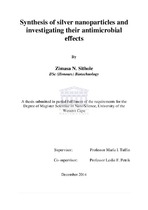| dc.description.abstract | Water is essential for life, yet access to safe drinking water is still a major concern worldwide due to waterborne diseases. The current study proposes silver nanoparticles (AgNPs) as an antibacterial agent. Silver nanoparticles were synthesised using different reductants and stabilisers, and the resulting structures were characterised with Ultra-violet visible (UV-vis) spectroscopy, transmission electron microscopy (TEM), energy-dispersive spectroscopy (EDS) analysis. The antibacterial properties of the AgNPs were tested against a panel of 5 indicator organisms: Cupriavidus metallidurans, Staphylococcus epidermidis, Mycobacterium smegmatis, Bacillus cereus and a multi-drug resistant Escherichia coli 1699. Spherical AgNPs that absorbed at around 400 nm, with diameters ranging between 18.8-26.4 nm or 5.4-13.1 nm were prepared by ascorbic acid or sodium borohydride respectively. The optimum processing conditions that produced 6±1.8 nm spherical nanoparticles included maintaining the temperature at 0 ⁰C, the pH at 9.78 and the NaBH4/Ag/PVP ratio at 16:1:10. Exposing AgNPs to light for 6 hours did not alter the particle size rather it changed the particles shape from spherical to icosahedral. Stirring caused particles to agglomerate, however, no agitation resulted in the formation of irregular structures of different sizes. Sensitivity to the AgNPs ranged between 25 % and 100 % reduced bacterial growth depending on the strains used and the concentration of the AgNPs. The Gram negative bacteria were more sensitive to AgNPs than Gram positive bacteria. However silver ions were more toxic than AgNPs for all but one of the strains tested, B. cereus was completely resistant to both Ag+ and AgNPs. C. metallidurans and E.coli (1699) showed a dose dependent sensitivity to AgNPs and the minimum inhibitory concentrations were established at 50 and 20 mg/L AgNPs respectively. C. metallidurans and E.coli (1699) were also eradicated by 10 mg/L Ag+. The E. coli TEM images showed accumulation of AgNPs within the cells, cell shrinking and leakage of cellular components. This suggests that AgNPs have a similar toxicity effect on bacterial cells as Ag+. | en_US |

